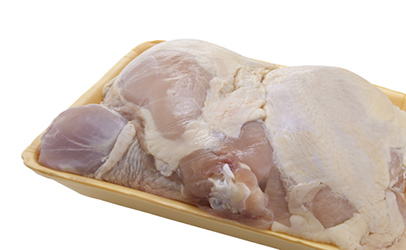Not too long ago I shared the Glossary information in Cook Live Learn concerning Beef. In this post, I want to continue with another informational treatise from the Glossary; this time on Chicken. It is an important part of our nutrition and health management these days and requires respect in handling and use.
From the Glossary of Cook Live Learn, A Cookbook for the Soul.
Chicken. More chicken is consumed than any other type of poultry in the World. The bird is domesticated making it easily raised. Believe me, in the Third World, they are running around everywhere! It is cooked in every way imaginable, but should never be served raw. Here are additional facts you need to know:
How to Buy Chicken. It is sold in pieces or whole, with the bones in tact, boneless, with skin or skinless and every combination of the foregoing! Chicken can readily be purchased as Organic, Natural (sort of Organic) and Regular. This is one food item that I prefer to buy organic, if possible. However, by all means, make sure you buy chicken raised without hormones (“Natural” will not have antibiotics either, if you can afford it). Make sure to consider the “Sell By” and/or “Use By” date(s) on the packaging and honor those. Basically, if it does not look good in the package (plump, smooth, no discolorations, etc.), do not take it home! Also, chicken should be stored at less than 40 degrees. If it does not feel cold, pass. Frankly, I will not buy chicken sitting in bloody water in its tray, if for no other reason than it is going to leak creating a mess or worse.
How to Handle Chicken. All meats have the capability of harboring bacteria. In the case of chicken, it is salmonella that we have to worry about most. Fortunately, thorough cooking will eliminate this threat, but safe handling must be practiced between the package and the pan to prevent cross-contamination and to keep the chicken as germ-free as possible! Cross-contamination occurs when other foods come in contact with raw chicken. Say, you pound chicken on your cutting board, then prepare vegetables there without washing the board in between. Wash your hands often. Do not thaw on the countertop or microwave. The outside of the chicken will warm and promote bacteria. Frozen poultry should be thawed in the refrigerator at under 40 degrees. Depending on the mass to be defrosted, this could take two days. Fresh chicken (unfrozen) should be used within two days. Chicken requires planning for utmost safety.
How to Tell When Chicken is Done. The absolute best way to tell when chicken is done is by taking its internal temperature, which needs to be 165 F degrees. I use a utility thermometer for this purpose. When taking the temp, be sure not to hit a bone or push the spike all the way to the pan – the middle of the piece is the place. Normally, recipes will instruct that chicken is done when the juices run clear when a piece is pierced with a fork. I have never had a problem with that method on single pieces, but would not trust it for a whole bird.
How to Boil Chicken. A number of recipes call for “cooked chicken”, such as Chicken Salad, chicken casseroles and others. The easiest way to prepare cooked chicken is to boil it on the stove top. To do so, remove the skin if present and wash the chicken pieces desired under the tap. Then place in a pot large enough to contain them, plus a couple of inches in height. Fill with water to cover. Turn the heat to medium high under the pot. Add salt and ground black pepper to the water (quantities depend on the amount of chicken; use common sense). Toss in a stalk of celery cross-cut into thirds, a 1/4” – 1/2″ thick slice from a medium yellow onion, a 3” or 4” length of peeled carrot, 2 crushed cloves of garlic and a small bay leaf. Boil until done. Once the chicken is removed for its purposes, you will have a bonus of some delicious chicken stock. Use a slotted spoon or strainer to remove the vegetables; discard. It will keep 3 months frozen. Depending on the quantity, store the stock in separate containers or freezer bags for ease of use later.
Note: Information in the above topic applies to all poultry
Credit: Thanks to FoodSafetyNews.Com for the chicken picture



No Comments